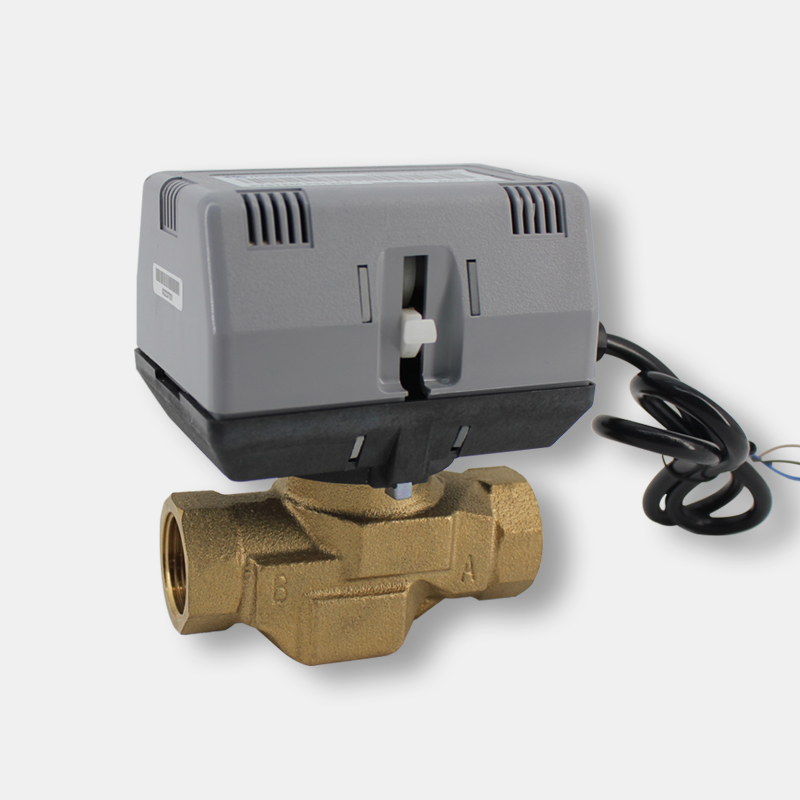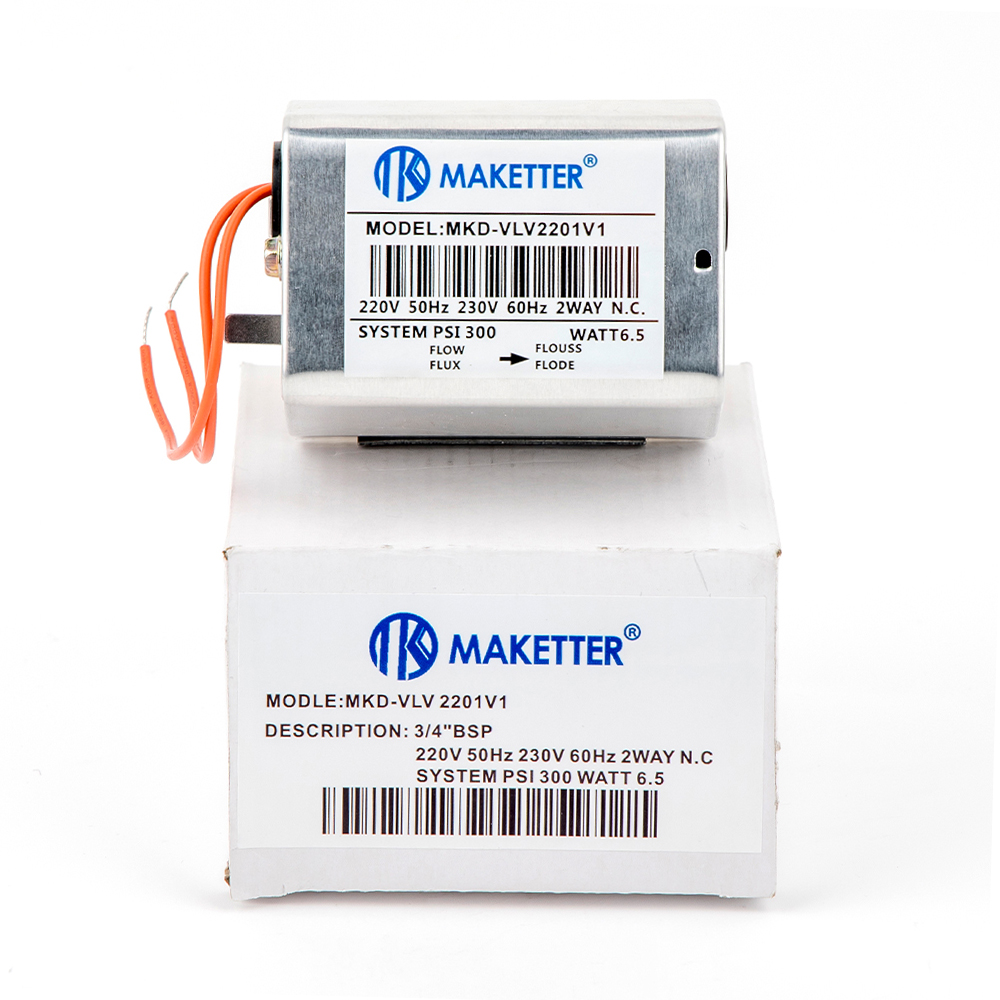
Electric Valve


Fan coil electric valve two-way/three way valve motorised valves MKD-VLV 2201V1
Use to control the supply of the fan coil units, chilled or hot water to maintain the room temperature.
Three type: internal thread 15mm,20mm & 25mm.
On/Off type,2-way normally-closed and 3-way diverting.
Use fully-enclosed one-way hysteresis synchronous motor, with spring return and waterproof function.
The actuator assembles the valve body quickly and easily without the need for linkages and calibration.


Fan coil electric valve two-way/three way valve motorised valves MKD-VLV 2201V1
Use to control the supply of the fan coil units, chilled or hot water to maintain the room temperature.
Three type: internal thread 15mm,20mm & 25mm.
On/Off type,2-way normally-closed and 3-way diverting.
Use fully-enclosed one-way hysteresis synchronous motor, with spring return and waterproof function.
The actuator assembles the valve body quickly and easily without the need for linkages and calibration.
Electric valves are devices that are used to control the flow of fluids such as water, air, gas, or steam. These valves are powered by electricity and can be operated remotely. They are commonly used in heating, ventilation, and air conditioning (HVAC) systems, industrial processes, and other applications where the precise control of fluid flow is necessary. Electric valves can be designed to operate on different types of power sources, including AC or DC power, and they can be configured to work with different types of control systems such as programmable logic controllers (PLCs) or building automation systems (BAS). Some electric valves are designed to be compact and can be integrated directly into pipelines or other fluid flow systems, while others are designed as standalone units that can be mounted on a wall or other surface. Electric valves can also be classified based on their operating mechanism, which may be either solenoid-based or motor-based. Solenoid valves use an electromechanical solenoid to actuate the valve, while motorized valves use an electric motor to control the valve’s opening and closing.
Functions of electric valve
Electric valves are devices used to control the flow of fluids in a system, such as in plumbing or HVAC systems. They are typically controlled by an electric signal and can be used to start, stop, or regulate the flow of liquids or gases. The main functions of electric valves include:
Control of fluid flow: Electric valves are used to regulate the flow of fluid through a pipeline or channel. By adjusting the position of the valve, the flow rate can be increased or decreased as required.
Shut-off control: Electric valves can also be used to shut off the flow of fluid completely. This is useful in emergency situations or when maintenance work needs to be carried out on the system.
Remote control: Electric valves can be controlled remotely, allowing for easy operation and monitoring of the system. This is particularly useful for large or complex systems where manual control is impractical.
Automatic operation: Electric valves can be programmed to operate automatically based on various parameters such as pressure, temperature, or flow rate. This allows for efficient and reliable operation of the system without the need for constant human intervention.
Energy conservation: Electric valves can help conserve energy by regulating the flow of fluids based on demand, reducing waste and optimizing efficiency.
Electric valve features
Electric valves have several features, including:
Automation: Electric valves are designed to open and close automatically, which eliminates the need for manual operation.
Energy Efficiency: Electric valves consume less power than traditional valves, making them more energy-efficient.
Precision: Electric valves have precise control over the flow of fluid, which helps to optimize the performance of the system.
Durability: Electric valves are made of high-quality materials that make them durable and long-lasting.
Remote Control: Electric valves can be controlled remotely using a computer, phone, or tablet, making them easy to use and convenient.
Flexibility: Electric valves are designed to work with a wide range of fluids, temperatures, and pressures, making them versatile and flexible.
Safety: Electric valves have built-in safety features that protect against overpressure, over-temperature, and other hazards.
Application scenarios of electric valve
Electric valves are widely used in various industrial and commercial fields, including heating, ventilation, air conditioning, refrigeration, water treatment, chemical processing, and more. They are commonly used in HVAC systems, where they are used to regulate the flow of water or air in pipes and ducts. Electric valves are also used in water treatment systems to regulate the flow of chemicals or to control the flow of water in pipes. In chemical processing plants, they are used to control the flow of various chemicals and gases in pipes and reactors. Overall, electric valves are an essential component in many industrial and commercial applications that require precise control of fluid flow.
Advantages of electric valve
Electric valves have several advantages over traditional manual valves, including:
Automation: Electric valves can be automated and remotely controlled, allowing for precise and accurate control of fluid or gas flow.
Energy efficiency: Electric valves can be programmed to optimize energy usage by turning off when not needed, reducing waste and lowering operating costs.
Reliability: Electric valves are typically more reliable and have longer lifetimes than manual valves, reducing maintenance and replacement costs.
Safety: Electric valves can be programmed to shut off automatically in the event of an emergency, protecting workers and equipment from damage.
Compatibility: Electric valves can be integrated with a variety of control systems, making them suitable for a wide range of industrial and commercial applications.
Electric valve installation methods and precautions
Here are some possible ways to describe the installation methods and precautions for electric valves:
Installation methods:
- Determine the installation location and orientation of the electric valve according to the pipeline system and the working conditions.
- Connect the electric valve to the pipeline using appropriate fittings and install it firmly.
- Make sure that the valve stem is aligned with the pipeline axis and that the valve disc is fully open or closed according to the installation requirements.
- Connect the electric actuator to the valve stem and make sure it is securely fastened.
- Install the control wiring and power supply wiring according to the wiring diagram, and make sure the wiring is correct and secure.
Precautions:
- Ensure that the electric valve is installed correctly and that the valve disc is in the fully open or closed position before the electric actuator is installed.
- Do not exceed the specified torque or thrust when operating the electric valve to prevent damage to the valve or actuator.
- Ensure that the power supply voltage is within the specified range and that the wiring is correctly connected before turning on the power supply.
- Ensure that the electric valve is not subjected to excessive vibration or impact during operation to prevent damage to the valve or actuator.
- Regularly inspect and maintain the electric valve and actuator to ensure proper operation and extend service life.
Electric valve maintenance recommendations
To maintain the performance and prolong the lifespan of an electric valve, it is recommended to follow these maintenance practices:
Regular inspection: Inspect the electric valve periodically to ensure that it is functioning properly. Check for any leaks, signs of corrosion or damage to the valve and its components.
Lubrication: Lubricate the valve’s moving parts as per the manufacturer’s recommendations. This will prevent friction and ensure smooth operation of the valve.
Cleaning: Clean the valve and its components to remove any debris or dirt that may have accumulated over time. This will help prevent clogging and ensure that the valve functions properly.
Calibration: Calibrate the valve periodically to ensure that it is operating within the desired parameters. This will help maintain the accuracy and reliability of the valve.
Replacement of components: Replace any worn out or damaged components of the valve promptly to avoid further damage or malfunctioning of the valve.
Professional servicing: If there are any issues with the valve that cannot be resolved through regular maintenance, it is recommended to seek professional servicing to ensure that the valve is repaired properly and safely.
By following these maintenance practices, the electric valve can be kept in good working condition, ensuring reliable and efficient performance over a long period of time.
Work with Us
Contact us to get the newest quotation. You will find yourself working in a true partnership that results in an incredible experience.
Work with A Control Equipment Factory Trusted by 1000+ Brands
Contact us to get the newest quotation. You will find yourself working in a true partnership that results in an incredible experience.
Get to know us
Contact Us
- [email protected]
- +86 19951935566
- +86 19951935566
- Wudong Hall, Biyang Town, Yi County, Huangshan City, Anhui Province, China
Power by Easyceotech

